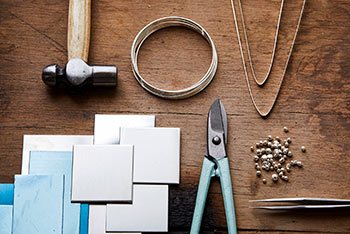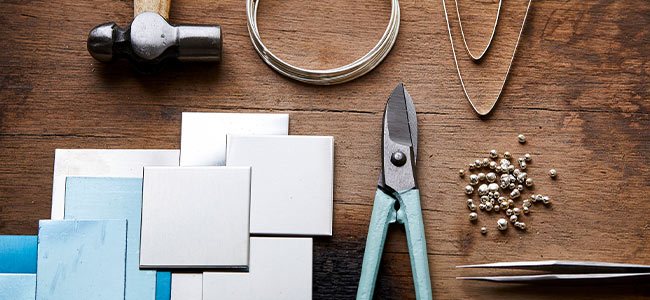When you first start in jewellery making, there are a number of terms that may sound unfamiliar. This is why we have put together a Glossary of Jewellery Terms to make it easier for our jewellery making customers that are just beginning in the jewellery making world and would like to see all the jargon that is commonly used in one place.

| Alloy | A mixture of different metals. |
| Annealing | The heating and cooling of metal, (often using a torch) to make it softer and therefore easier to work. |
| Assaying | The testing of metal by a professional body (Assay Office) to determine the percentage of pure precious metal contained within it. Once established, the metal is marked with the appropriate hallmark. |
| Base Metal | Non-precious metal e.g. copper, aluminium etc. |
| Bevelled | Slanted or sloping. |
| Bezel | Ring of metal used to secure a stone in a rub over setting. |
| Blanks | Plain, flat shapes cut out of sheet metal, (often stamped). |
| Borax | A type of flux which enables solder to run cleanly. |
| Buff Stick | A round, half round or rectangular stick with sand or emery paper wound round it, used for sanding objects before polishing. |
| Burnish | The process of rubbing metal to achieve a high polish. |
| Carat | a) Unit of weight used to measure gemstones. (A carat is equal to 1/5 of a gram). b) Used to measure the purity of gold. It is defined as parts per 24 with 24 carats being pure So, for example 18 carat gold contains 18 out of 24 parts pure gold. UK legal standards of gold are 9ct, 14ct, 18ct, 22ct and 24ct. It is sometimes written as 9k following the American spelling Karat to avoid confusion with stone weights. |
| Chasing | The process of punching a relief design into the front of a piece of metal. |
| Chenier | A piece of thin metal tubing. |
| Countersink | The widening of an entry to a hole. |
| Collet | A metal collar that surrounds and holds a stone. |
| Culet | A tiny facet cut onto the point of some gemstones. |
| Draw Plate | A metal plate containing a series of holes of different sizes and shapes. Wire can be drawn through the holes to reduce the size or change the shape. |
| Electroforming | The process of depositing a layer of metal into a mould via an electrical current to form an object. |
| Electroplating | The process of depositing a layer of metal onto an object via an electrical current to give it a metallic appearance. Any object can be electroplated, it doesn’t have to be made of metal. |
| Engraving | Is the technique of cutting away the surface of metal using steel tools called gravers. Lines and lettering often form the basis of engraved designs. |
| Etching | Is the removal of a surface using acid in a controlled environment. The acid literally eats through the metal creating patterned relief. |
| Facet | A flat surface ground onto a stone by a trained lapidary or diamond cutter. |
| Ferrous | A metal containing iron. |
| Findings | Functional components, normally mass produced e.g. catches, earring wires etc. which allow jewellery to be worn on the body. |
| Fire Stain (Fire scale) | Black or grey marks which appear on the surface of silver when it is heated. (They appear because of the presence of copper in the alloy). |
| Flux | A liquid or paste that is painted onto metal to enable solder to flow freely and cleanly. |
| Forging | The use of hammering to alter the shape and profile of metal. |
| Former | A hardened steel shape used to support metal whilst hammering. Also known as a mandrel. |
| Fretwork | A sheet of metal which is pierced with holes and/or shapes to form a decorative pattern. |
| Gallery | a) A wire used in jewellery to raise the level of a piece to allow sufficient clearance for stones b) A mass produced, decorative strip used to make stone settings. |
| Gauge | A standard unit of measure used for metal sheet and wire. |
| Gilding | The application of a thin layer of gold or gold alloy to another material. |
| Girdle | A term used to describe the widest circumference of a gemstone. It marks the boundary between the top (crown) and the base (pavilion). |
| Granulation | The decoration of a metal surface using tiny balls of gold or silver. |
| Hallmark | A stamped impression applied to precious metal objects displaying information such as metal fineness, makers mark and the city in which it was assayed. These marks act as a guarantee for consumers. |
| Jig | A tool or apparatus used to produce a series of identically shaped items. |
| Pallions | Tiny pieces of solder. |
| Patina | A surface finish which can develop naturally over time or as a result of exposure to chemicals. |
| Pickle | A mildly acidic cleaning solution which removes dirt and oxides from metal that are produced during heating and soldering processes. |
| Piercing Saw | A saw with an extremely thin blade that can be threaded through a drilled hole, used to cut out sheet metal. |
| Art Clay | Clay made from tiny particles of pure metal held together in an organic binder which can be burnt away to reveal a solid metal object. |
| Planishing | The technique of repeatedly hammering metal using a polished hammer to remove surface marks, creating an even finish. |
| Repousse | Patterned relief which is punched or hammered into metal from the reverse. |
| Rouge | Polish used for the final stage of precious metal polishing, usually in conjunction which a high-speed motor and soft mop. |
| Shank | The functional part of a ring that goes around the finger. |
| Soldering | The process of permanently joining pieces of metal together using heat and an alloy called solder which runs at a lower temperature than the metal itself. |
| Sprue | Excess metal piece attached to a casting created via the access chan |
| Stamping | The creation of impressions and patterns onto sheet metal using punches and a single blow delivered by a hammer or fly press for larger production runs. Stamping can also be used to completely cut out metal shapes. |
| Tang | The non-working end of a file or tool which fits into the handle. |
| Tempering | The process of heating metal post hardening to reduce brittleness. |
| Triblet | A tapered metal former used for shaping rings. |
| Tripoli | A coarse polishing compound with abrasive qualities used in the initial stages of polishing precious metal. |
| Work hardened | This is the term used to describe metal which has become too tough to work due to repeated hammering or bending. You can reverse this process by annealing. |

Written by
Cooksongold

